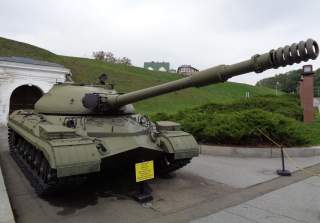The Inside 40-Year Story of Stalin's Massive T-10M Tank
It just kept going and fighting.
Key point: The T-10 design was successful and very long-running.
The T-10 is one of the longest lasting tank designs in the world. Adopted in 1953, the tank served for over 40 years before finally being decommissioned in 1997.
Along the way, the design underwent several revisions to keep it modern, from the T-10A to the ultimate variant, the T-10M.
But what made the T-10 design so enduring? Just how good was the T-10M? Why was it kept in service so long?
The story of the T-10 beings in 1949. Originally called the IS-8 and IS-9 during development, the T-10 was a continuation of the Iosef Stalin line of heavy breakthrough tanks that debuted during WWII.
IS-2 heavy tanks were the standard late-war heavy tank of the Soviet Army, possessing a powerful D-25 122mm gun that could blast through enemy tanks and bunkers alike.
That gun would go on to be a hallmark of the IS-series, arming the later IS-3, IS-4, and eventually the IS-8, which would be adopted as the IS-10. Following Stalin’s death in 1953, the IS-10 was renamed T-10 as part of the destalinization process.
The T-10 itself was a modernization of the IS-3, featuring the same “prow” front hull design, complete with the centrally situated driver’s position. The turret and hull were enlarged from the IS-3 to accommodate more armor. This necessitated the addition of another road wheel.
The D-25 was also beefed up with a longer barrel and bigger muzzle brake to allow for the firing of advanced armor-piercing rounds.
To help address a common weakness of the IS-series, low rate of fire, an electromechanical rammer was added to the T-10 to assist the loader. 30 rounds were available in an ergonomic configuration superior to earlier IS-tanks.
Altogether, this made for an incredibly formidable tank in the 1950s, with very thick armor and impressive lethality to boot. While not as nimble as upcoming Western tank designs, the T-10 was meant to be able to survive a hit.
The first upgrade for the T-10 came in 1956 in the T-10A. The T-10A was a fairly straightforward lethality upgrade. A fume extractor was added to the D-25, and the “Uragan” vertical-axis stabilizer was added to the T-10. This improved the ability of the T-10 to fire on the move by 5-6 times.
The T-10B came shortly afterward in 1957, featuring a 2-plane stabilizer.
The final variant, the T-10M was adopted in 1962. It was an almost total overhaul of the design, with the original D-25 cannon being swapped out for a more modern M62T2 cannon which featured yet another new muzzle brake and fume extractor. It also had a newer, more effective stabilizer.
The coaxial armament was also improved, swapping the 12.7mm DShK machine guns for 14.5mm KPV machine guns.
A myriad of other improvements round out the T-10M: night vision equipment for the gunner and driver, improved nuclear protection measures, and better sights.
But at that time the next generation of Western and Soviet tanks was well into development. The original T-10 had far better armor than the T-55s and T-54s that were its contemporary, but the T-10M didn’t possess significant advantages versus the T-62, much less the upcoming T-64 which utilized composite armor.
In the end, the reason why the T-10M stuck around was likely institutional inertia. Soviet doctrine called for an extremely heavily armed breakthrough tank, and the T-10M was the tank for that job.
This doctrine didn’t stick around for much longer given the suitability of faster, lighter tanks at exploiting breakthroughs, but at the time, it was a perfectly valid reason to keep churning out T-10s.
The T-10 was actually better in some ways than the newer tanks, perhaps simply due to its size. The stabilizer was more effective than the T-62s, and of course the high caliber coaxial and commander weapons fit is nothing to scoff at. These aspects would likely have made it a force to be reckoned with on the breakthrough in the 1960s when ATGMs were still in their infancy.
Charlie Gao studied political and computer science at Grinnell College and is a frequent commentator on defense and national-security issues. This first appeared in December 2018.
Image: Reddit.

